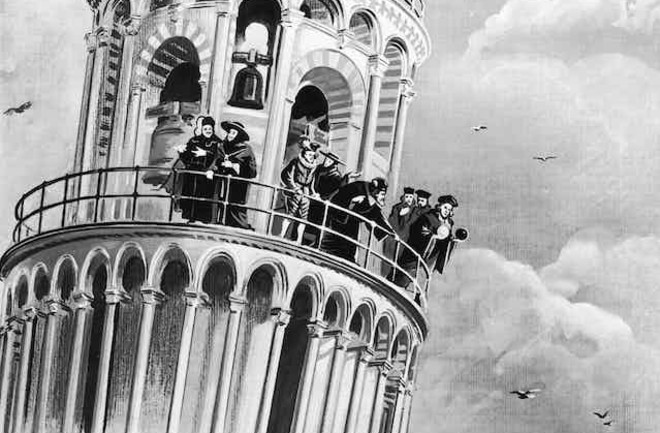If you drop a light object and a heavy object from a tower, which one reaches the ground first? As you may recall from high school physics, this is a trick question. Neglecting air resistance, they both fall the same way and reach the ground at the same time – gravity means that their speeds increase at 9.8 meters per second squared, no matter what their mass.
That’s the premise behind Galileo Galilei’s Leaning Tower of Pisa experiment, a classic thought experiment in the field of dynamics.
Dynamics is the physics specialization that studies motion and force. A “dynamicist,” one who studies dynamics, can do everything from improve a basketball player’s free throw to help design spacecraft for interstellar travel.
As a dynamicist, I’ve spent much of my career helping students make sense of modern dynamics. The Leaning Tower of Pisa experiment is one good way to do this. It can explain how classical mechanics – the field that engineers and educators employ every day – was brought into the modern world.
Galileo’s Leaning Tower of Pisa experiment
The Leaning Tower of Pisa experiment led to the curious realization that objects fall with the same accelerations regardless of their mass. But what happens when you place objects of different masses on a smooth table and push each of them with the same force?
Even without accounting for friction, the objects’ accelerations are now different. The lighter objects accelerate more than the heavy ones. When falling, their accelerations are the same, yet when sliding, they’re different.
Let’s now place the two objects in orbit. Imagine one of them is the Sun and the other is the Earth. In classical mechanics, the Sun exerts a force on the Earth equal in magnitude to the force that the Earth exerts back on the Sun.
But the Sun is huge compared with the Earth. Shouldn’t the magnitude of the larger object’s force be larger? And while we’re at it, how would the magnitude of the Sun’s force on the Earth come to be equal to the magnitude of the Earth’s force on the Sun?
Heavy and light objects have equal accelerations when falling but different accelerations when sliding, and objects in space exert equal gravitational forces on each other despite having different masses. This all seems inconsistent, and a little confusing, right?
Modern mechanics
The problems above came from an ambiguity in the concept of force in classical mechanics. In classical mechanics, the force is an interaction between two objects, involving both objects. The magnitudes of the gravitational forces by the Sun and by the Earth depend on the masses of both bodies. The force was never just by the Sun or just by the Earth without regard to the other.
But modern mechanics – the physics of light, atoms, quantum mechanics and curved space-time – changed this concept of force. The modern force by the Sun and the modern force by the Earth are two separate forces, and they depend only on their own masses, excluding relativistic effects.
In modern mechanics, the force is now an action by an object, not an interaction between them. It is viewed as a force field that radiates outward from its source, whose magnitude grows smaller the farther it is from its source. Modern mechanics is a field theory – it deals with objects and the accelerations their force fields create.
So, what happened to the interaction force? Was it discarded? The answer is no, but it is no longer the most fundamental definition of force, either. In modern mechanics, the interaction force, represented by the letter F, is defined in terms of the action force field, represented by the letter P. The interaction force is now the action force P times the mass m on which P acts, so F = mP.
Newton’s second law of motion, a fundamental part of classical mechanics, sets the interaction force F by an object equal to the mass m on which the object acts multiplied by its acceleration, so F = ma. The modern version sets the action force P by an object equal to the other object’s acceleration, so P = a. When multiplying P = a by m we get back F = ma.
Notice it was not about the math in classical mechanics being wrong – but more about the fundamental force being an action force and not an interaction force.
The modern thinking
The modern thinking reinterprets Galileo’s Leaning Tower of Pisa experiment, the sliding blocks, the orbiting of the Earth around the Sun – and interactions in general.
In Galileo’s Leaning Tower of Pisa experiment, the light and heavy objects were falling due to the Earth’s action force, which does not depend on the masses of the falling objects, so their accelerations are naturally the same.
The light and heavy objects sliding on the smooth table were acted on by the same interaction forces. But the fundamental forces – the action forces – are different, so their accelerations are naturally different, too.
In the orbiting of the Earth around the Sun, the action forces by the Sun and by the Earth are no longer equal. The action force by the Sun, with its huge mass, is proportionally larger than the force by the Earth – as intuition suggests.
Science takes many years to evolve as it edges closer to revealing the nature of reality. One sees this in the evolution that led to modern mechanics – where scientists now embrace a theory of force fields that predicts the dynamics of objects, despite it being almost against common sense.
Larry M. Silverberg is a Professor of Mechanical and Aerospace Engineering at North Carolina State University. This article is republished from The Conversation under a Creative Commons license. Read the original article.

